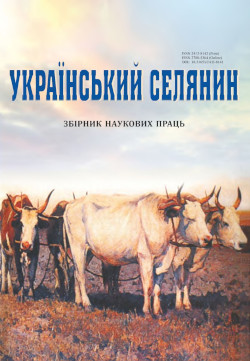Transformation of traditional children’s clothes of Ukrainians at the late of the 19th – middle of the 20th century
Main Article Content
Abstract
The purpose of the article is to study changes in traditional Ukrainian children’s clothing from the late of the 19th to the middle of the 20th century, to determine the main factors that influenced children’s clothing culture, the degree of preservation of traditional practices and ideas, and the features of innovations.
The scientific novelty lies in the fact that the author characterized the defining aspects of the transformation of traditional children’s clothing, the peculiarities of his daily life in the specified period, the factors that influenced it.
Conclusions. Children’s clothing complements our idea of folk clothing, to a large extent illustrates the attitude towards the child, understanding of its needs and development, involvement in work, role in society. The issue of changes in children’s clothing reveals some features of transformational processes in society. In the first half of the 20th century the Ukrainian people suffered a difficult historical fate, wars and famines, ideological repressions and repressions caused inevitable changes in the people’s existence. At the same time, the time of progress, urbanization processes, changes in the economic system and worldview influenced the departure from traditional ideas and practices. These processes also affected children’s clothing culture, which met the challenges of time and cultural transformation. By the middle of the 20th century. ceremonial and symbolic aspects related to children’s clothing were preserved by Ukrainians, which indicates the important role of the traditional worldview, observance of ancient customs. Imitation of some older practices, such as the permissible minimal amount of children’s clothing, finds an explanation both in following the usual way of life and in the impossibility of improving children’s life. Therefore, various aspects of the people’s life, changes in the economic system, culture, and the consequences of historical upheavals were reflected in the
children’s clothing.
Article Details
References
Borysenko, V. (2016). Simeyna obriadovist ukraintsiv XX – pochatku XXI stolittia. [Family Rites of Ukrainians of the 20th – Early 21st Century]. Kyiv : IMFE im. M. T. Rylskoho NAN Ukrainy, 2016. 256. [in Ukrainian].
Bosyi, O. (2000). Znakovi funktsii tkanyny v zvychaievo-obriadovii sferi ukraintsiv (semantychni paraleli «kryzhmo» – «savan») [Symbolic functions of fabric in the customary and ritual sphere of Ukrainians (semantic parallels «kryzhmo» - «savan»)]. Etnichna istoriia narodiv Yevropy. [Ethnic history of the peoples of Europe], 4, 114–117. [in Ukrainian].
Derlytsia, M. (1898). Selianski dity. [Peasant Children]. Etnohrafi chnyy zbirnyk. [Ethnographic collection], 5. [in Ukrainian].
Etnohrafi chnyy obraz suchasnoi Ukrainy. Korpus ekspedytsiynykh folklorno-etnohrafi chnykh materialiv. Rodylna obriadovist. [Ethnographic Image of Modern Ukraine. Corpus of Expeditionary Folklore and Ethnographic Materials. Birth ritual]. (Ed) Skrypnyk, H. (2016). NAN Ukrainy; IMFE im. M. T. Rylskoho. Kyiv, 3. [in Ukrainian].
Etnohrafi chnyy obraz suchasnoi Ukrainy. Korpus ekspedytsiynykh folklorno-etnohrafi chnykh materialiv. Tradytsiyne povsiakdenne ta obriadove vbrannia]. [Ethnographic Image of Modern Ukraine. Corpus of Expeditionary Folklore and Ethnographic Materials. Traditional Everyday and Ceremonial Clothing]. (Ed) Skrypnyk, H. (2018). Kyiv, 10. [in Ukrainian].
Hrushevskyi. M. (2006). Dytyna u zvychaiakh i viruvanniakh ukrainskoho narodu. [A child in the Customs and Beliefs of the Ukrainian People]. Kyiv : Lybid. 253. [in Ukrainian].
Hurosheva, N. (1995). Tradytsiynyi ukrainskyy dytiachyy odiah. Narodna tvorchist ta etnohrafi ia. [Traditional Ukrainian Children’s Clothing. Folk Art and Ethnography], 1, 77–82. [in Ukrainian].
Karpacki świat bojków i łemków, Roman Reinfuss. Fotografi e. (2015). [The Carpathian world of Boikuw and Lemkuw, Roman Reinfuss] Opr. Hubert Ossadnik i prof. hab. Zbigniew Libera, Wyd. Bosz, 248. [in Polish].
Kotsan, V. (2021). Etnokulturni markery v konteksti pohranych: tradytsiynyy narodnyy odiah ta identychnist naselennia Zakarpattia 20 – pochatku 21 st. Kvalifi katsiyna naukova robota na pravakh rukopysu. [Ethnocultural Markers in the Context of Borderlands: Traditional Folk Clothing and Identity of the Population of Transcarpathia of the 19th – Early 21st Century], Lviv. Retrieved from https://shron1.chtyvo.org.ua/Kotsan_Vasyl/Etnokulturni_markery_v_konteksti_pohranych_tradytsiinyi_narodnyi_odiah_ta_identychnist_naselennia_Za.pdf? [in Ukrainian].
Maierchyk, M. (2011). Rytual i tilo: strukturno-semantychnyy analiz ukrainskykh obriadiv rodynnoho tsyklu. [Ritual and the Body: Structural-Semantic Analysis of Ukrainian Rites of Family Cycle]. Kyiv : Krytyka. [in Ukrainian].
Materialy do etnolohii. Pobut selianskoi dytyny : materialy do monohrafi i s. Starosillia. Nina Zahlada. [Everyday Life of Peasant Children: Materials for a Monograph on the Village of Starosillia]. (1929). Kyiv, 1. [in Ukrainian].
Miloradovich, V. (1897). Narodnye obriady i pesni Lubenskoho uezda Poltavskoy hubernii, zapysannye v 1888–1895 h. [Folk Rites and Songs of Lubny County of Poltava Governorate, Recorded in 1888–1895]. Sbornyk Kharkovskoho istoriko-fi lolohycheskoho obshchestva. [Collection of the Kharkov Historical and Philological Society]. Kharkov : Typ. hubern. Pravleniia, 16. [in Russian].
Onyshchuk, A. (1912). Z narodnoho zhyttia Hutsuliv. [From the Hutsuls’ National Life]. Materialy do ukrainsko-ruskoi etnologii [Materials for Ukrainian-Russian ethnology], Lvovi: Z druk. Nauk. t-va imeni Shevchenka 15. [in Ukrainian].
Selivatchov, M. (2023). Silska moda XX stolittia v ukrainskomu vbranni ta tekstyli. [Rural Fashion of the 20th Century in Ukrainian Clothing and Textiles] Narodna tvorchist ta etnolohiia. [Folk creativity and ethnology], 1 (397), 65–74. [in Ukrainian].
Shuhevych, V. (1902). Hutsulshchyna. [Hutsul region]. Materialy do ukrainsko-ruskoi etnolohii [Materials before Ukrainian-Russian ethnology]. Lviv : Zdruk. NTSh, 5. [in Ukrainian].
Trudy etnohrafi chesko-statisticheskoi ekspedytsii v Zapadno-Russkyy krayi, snariazhennoyi Imperatorskym Russkym Heohrafycheskym Obshchestvom. Yuho-Zapadnyi otdel. [Proceedings of Ethnographic- Statistical Expedition to the Western-Russian Land, Equipped by the Imperial Russian Geographical Society. South-Western Department]. (1877) Sankt-Peterburh : Tip. V. Kyrshbauma, 4. [in Russian].
Tureiskyi, I. (2022). Odiah yak instrument sotsializatsii dytyny v ukrainskiy tradytsiyniy kulturi kintsia 19 – pochatku 20 stolittia. [Clothes as an Instrument of Child Socialization in Ukrainian Traditional Culture of the Late 19th – Early 20th Century.]. Narodna tvorchist ta etnolohiia. [Folk creativity and ethnology], 3 (395), 102–110. [in Ukrainian].

